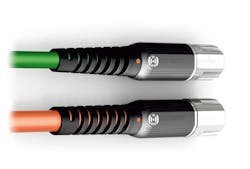The effect of advancing technology on controllers, drives, sensors and motors is hard to miss as these devices become increasingly connected, interoperable and integral parts of converged IT and operational technology manufacturing systems. But what’s not so easily seen is how the trend toward greater device connection and system automation is affecting even the cables and connectors that, quite literally, connect everything.
I saw a good example of this at the SPS/IPC/Drives event in Nuremberg, Germany, where TE Connectivity showcased connectors with embedded near-field communication (NFC) chips. With these chips embedded into the connectors, pla nt f loor personnel can use mobile devices to access information about the connectors without having to physically interact with the connector or disrupt operations. According to TE Connectivity, NFC-chip connectors can provide type and instance data. Type data includes information such as 3D models, test reports and product datasheets. Instance data includes unique connector information, such as mating cycles, temperature and cable age.
“Connectors with NFC chips will help industrial companies respond to many new challenges they have to face if they want to make their factories truly smart,” said Siegfried Funk, application manager, motor connectivity at TE Connectivity. “It all starts with the connector, because so much information passes through it. If we can tap into that information, communicate it and record it, we are well on the way to the digital factory. Our goal is to transform the concept of the smart factory into an operational reality. Smart connector technology, based on something as simple as an NFC chip, is a first step toward that goal.”
In addition to the ability to access operational data on the connector from the NFC chip, Funk says that these smart connector technologies can verify the authenticity of hardware for easier registration management and reduce the time needed for machine documentation and spare parts management.
Automated connections
One of the core tasks associated with any industrial cabling application is the assembly of the connectors to the cable for connection to a machine or device. And even that process is increasingly adapting itself to automation. To highlight this, TE Connectivity showcased its new HDC (heavy duty connector) Dynamic connectors that can be assembled using semi-automatic or fully automatic crimping of contacts. The use of standard dynamic contacts in the HDC line means the connectors can be processed on automated crimping machines using the same tool sets as wire-to-board connectors that use crimping technology.
This capability supports the trend of moving away from visual inspection to in-process monitoring methods. According to TE Connectivity, visual inspection has been shown to be much less effective, with up to 20 percent of parts not properly inspected. In-process monitoring methods ensure that each and every wire termination meets crimp force specifications.
The HDC Dynamic connectors can house between 3 and 48 contacts in a single module, with each connector capable of holding up to six modules. The connectors have current ratings from 2 to 40 Amps and handle over-voltage requirements up to 500 V. They can be used with existing contacts, frames, housings and hoods with protection ratings against water and dust of IP 20, IP 65 and IP 68/IP69K.


